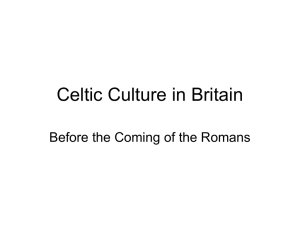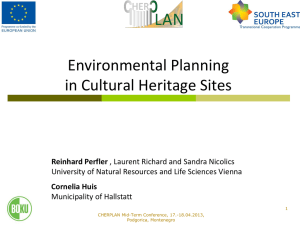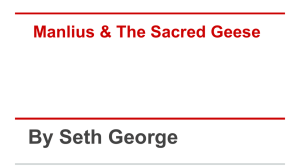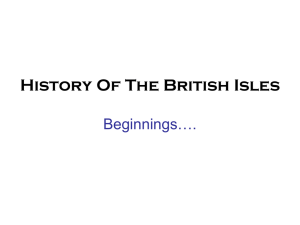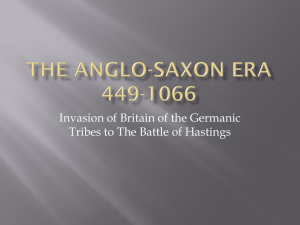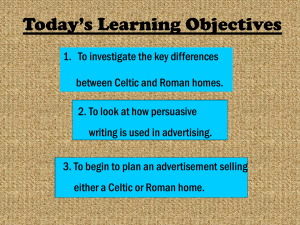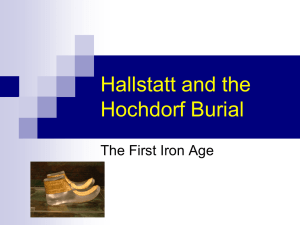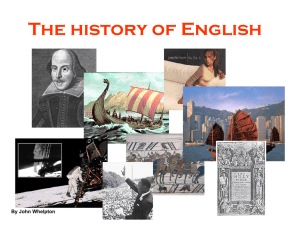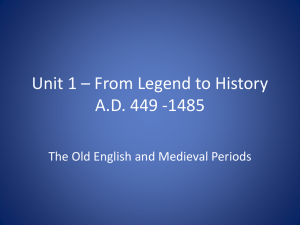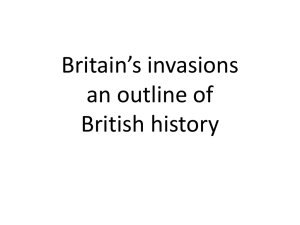Migrations1 - Université d`Ottawa
advertisement
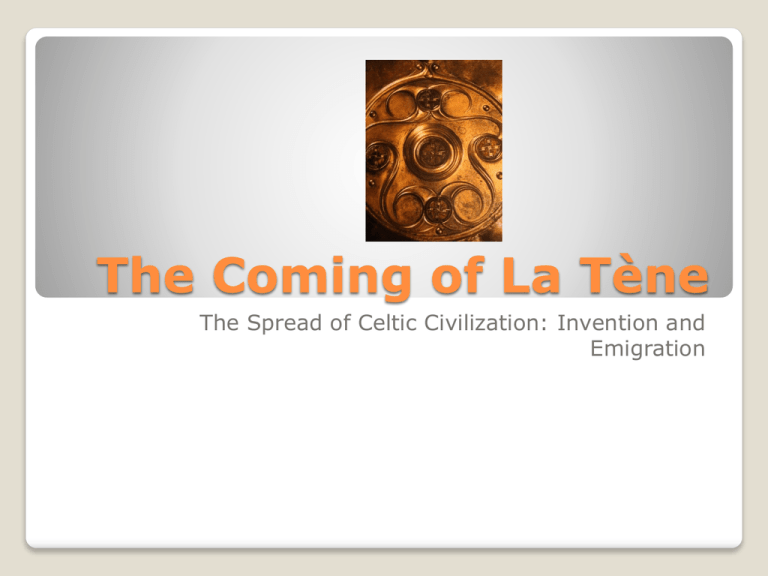
The Coming of La Tène The Spread of Celtic Civilization: Invention and Emigration CARNYX THE DYING GAUL BATTERSEA SHIELD LONDON c Change came from the north. One of these news focuses of power was to found some 150 kms NW of the old Hallstatt regions in the valley of the Moselle close to its confluence with the Rhine. It is possible that in this early period of La Tene there were two major centres of power, one in the Neckar region (Hohenasperg) and the other on the Moselle. La Tène Culture The Moselle region became more importandt by the end of that century (c400BC). Throughout this period contacts were maintained with the Etruscan world to the south (Italy). The second major area of innovation in the Early La Tene was in the Marne Valley, some 150 kms directly north of the old Hallstatt areas, eg Vix. La Tène Culture During the fifith century BC occupation of the area grew, and although one grave has been found with the Hallstatt four-wheeled cart, the majority of the cart burials have twowheels. Characteristically the dead aristocrat was buried in a pit accompanied by the vehicle, a range of horse-trappings and a drinking set. Some imports from Eturia and Greece also found. One Greek item dating to 420BC. La Tène Culture Marnian culture (ie on the river Marne) plays an important part in the development of a distinctive style of Celtic art. What was the relationship between the Moselle communities and those of the Marne? Both shared a common warrior-dominated social system and some levels of a common material culture, based on exchange networks. La Tène Culture Possibly though, Marne was dependant on Moselle for the importation of high status Mediteranean goods. The fifth century (400sBC) sees the development of communication extending from the Po valley in Northern Italy, through the territory of the Veneti (Venice and the region around), along the eastern fringes of the Alps, north to Bohemia. La Tène Culture In that area an important site developed, called Zavist south of Prague. It was established during the Hallstatt period, and later developed during the fifth century to be a major site. La Tène Culture It can be said that during the fifth century (early La Tene in the 400s BC), two regions can be identified as being areas of Celtic innovation: The Marne-Moselle zone in the west with its trading links with the Po Valley in northern Italy via the central Alpine passes, and a Bohemian zone in the east with links to the Adriatic via the eastern routes around the Alps. La Tène Culture Both these cultural zones had first begun to develop during the late Hallstatt periods. But it is noticeable that the core of the old Hallstatt so dominant in the late sixth and early fifth centuries (500s-400sBC) had now become cultural backwaters. (Hohenasperg). The centre had decayed, the periphery had flourished. Why? La Tène Culture Some have argued that changes in trading pressures from the Mediterannean had caused social dislocation north of the Alps, unbalancing the prestige goods economy. The Greek trade routes may have eventually favoured the west Mediteranean place more power in the hands of the Etruscans. La Tène Culture: what happened to Hallstatt But the causes may have little to do with the Mediteranean, but instead the social dynamics and pressures in the northern Alpine areas. Given the warrior nature of the peripheral society (with an emphasis on raiding) aggressive moves against the west Hallstatt may have destabilized and destroyed the old economic system. La Tène Culture With such developments taking place, even greater changes were about to bring closer contact between the Celticspeaking peoples of the new La Tene culture and those of the Mediterranean and neighbouring areas: The Celtic Migrations by about 400BC. La Tène Culture The fifth century BC is characterised by what seems to be the sudden demise of the Hallstatt civilisation. The important hillfort of Mont Lassois and Heuneberg were abandoned, and as a result the rich burials come to an end. The End of the Hallstatt Civilisation There may have been wars between the two vying Celtic cultures. The Heuneberg site was burned down but it cannot be ascertained whether this was because of internal strife or attack from outside. Some sites seem to show a continuity. Eg the Keinaspergle grave at Asperg. (This is the Hohenasperg region where Hochdorf is situated). The End of the Hallstatt Civilisation La Tene Civilisation The Classical Celtic Period The new era takes its name from a famous archaeological site in Switzerland. Once again it is mainly finds from cemetaries which provide us with an image of the first Celts. There are few written sources which document this period of emergence (c450BC), so we depend on archaeology. The Formation of La Tène Typical of this new era is a different artistic style, again subject to influences from the Mediterranean. This time however, this was not merely imitation of Greek and Etruscan originals, but gave rise to new creations with an unmistakable and original art-style. The Formation of La Tène Despite evidence of some continuity in the Hallstatt areas, there is considerable evidence that the areas immediately to the north (the cradle of La Tene culture) imported specific kinds of item from the north of Italy, items not found in the Hallstatt regions. This leads to the conclusion that a new trade axis had been formed linking the Moselle chieftains directly with the Etruscan cities of northern Italy (c500-450BC). The Formation of La Tène By the middle of the fifth century the centre of innovation in western Europe (Celtic Europe) had moved decisively away from the Burgundy-S. Germany axis (Hallstatt D), to the more northerly Marne-Moselle-Bohemia arc where the new La Tene culture flourished. The Formation of La Tène The spread of La Tene art styles throughout Europe was a remarkable phenomenon. It could be argued that La Tene art was the first truly pan-European art style. Its spread to the south and the east of the Marne-Moselle region was accelerated by folk movements. But its adoptionin the west and the north, as far as Ireland and Scotland, is a far more complex development. The Formation of La Tène In the British Isles and Ireland, we see, rather than immigration of La Tene peoples into the area, many levels of acculturation, involving the movement of actual objects by exchange to selective immitation of La Tene motifs by local craftsmen. The same process would have been true for much of Atlantic Europe, in western France, Spain and Portugal. The Formation of La Tène It has been suggested that knowledge of La Tene art spread to Britain and Ireland via Brittany (Armorica). Items found in Britain can be compared with variations of La Tene styles found in Brittany. But there is also evidence that other parts of Britain received their concepts of LT by way of the southern North Sea area, which would have impacted mainly on the East Coast of Britain. The Formation of La Tène These ‘trade routes’ had already been extensively used in the Bronze Age period. The Formation of La Tène The first representations of this art are found on brooches and clasps (fibulae), and later on scabbardsm swords, helmets, torques, knives, pottery, flagons, and coins. Wild life and imaginary animals are a frequent motif. Winged animals. Animals with human faces. Horses with human faces, birds heads, animal heads. The origins of the La Tène style Numerous attempts have been made to interpret such objets in the light of what we know about later Celtic religion. Some of the ‘mask fibulae’ which had human faces were buried for ritual reasons. But since most of this ‘new’ art seems not to be a direct development of Hallstatt art (eg the Hochdorf burial), what can be said about their origins? The origins of the La Tène style Paul Jacobsthal, one of the major scholars in the field of Celtic art, was responsible for developing the idea that, besides having Etruscan roots, the formal Celtic language of art, had other eastern European origins belonging to the Scythians and the Thracians, whose own art had been influenced by the Persians (Iranian art). The origins of the La Tène style There are undoubtedly characteristics which constitute common ground between the LT Celts and the eastern horsemen (see Herodotus, IV, 65-66= a reference to the fact that the LT Celts and the Scythians were head-hunters in war). Drinking horns, much beloved by the Celts (Hochdorf), were also typical of the Scythians, and other eastern peoples. (In Italy they are almost unknown). The origins of the La Tène style In Scythian culture, objects with animal heads are frequently found. From Kleinaspergle, one of the items found, the depiction of rams’ heads on the drinking horns is reminiscent of the Scythian artifacts from southern Russia. Perhaps the LT Celts did not have a welldeveloped trade system with peoples of the east (as they had with the Mediterranean peoples). The origins of the La Tène style But certain objects given as diplomatic gifts may have had a significant influence upon the emerging Celtic art of the early La Tene period. All the evidence suggests that, at the level of the ruling classes, there were indeed contacts. The origins of the La Tène style The new early La Tene chiefdoms retained some of the characteristics if their Hallstatt D predescessors, but were different in a number of ways: The La Tene burials which had an accompanying vehicle, now favoured a two-wheeled chariot (perhaps inspired by the Etruscans). Differences between Hallstatt and La Tene Another significant difference was the prevalence of weapons in the La Tene graves. Many of the male deceased, not only the elite, were accompanied by their swords and spears, and occasionally their helmets. In the Hallstatt D graves, only knives (for feasting and hunting) were generally found. Differences between Hallstatt and La Tene we may speculate: One possibility is that the communities to the north of the Hallstatt regions had for some time been occupied in raiding to acquire slaves and other commodities which they exchanged with the Hallstatt elites. Increasing demands for such commodities would have exacerbated their warlike tendencies. Differences between Hallstatt and La Tene Undoubtedly, the period c500BC was a time of upheaval, leading eventually to the dominance of elites and specifically, ‘peoples’ whom we call La Tene Celts. Within about one hundred years (c400BC), we witness huge folkmovements, now reflected in the classical writings of the Greeks, north of the Alps. Migrations of La Tène ‘Celts’. Celtic-speaking peoples poured through the Alpine passes, to conquer and raid northern Italy. They will settle in the Po Valley. With this major event, trade with Etruria ends, and a more detailed history of the Celts can begin. At the same time, other Celtic ‘peoples’ went east along the Danube river valley, and into the Balkans, and within a century had reached Greece, and eventually Anatolia (Turkey). Migrations of La Tène ‘Celts’. These were undoubtedly La Tene Celts, and probably most of the emigration came from Marne- Moselle areas. Some of the same tribal names are found there and in eastern France and northern Italy. However, the migrations may have come from a variety of areas. In many cases the archaeology cannot help. Note that there is no suggestion of migrations to Britain and Ireland. Migrations of La Tène ‘Celts’. What caused the migrations? Overpopulation seems to be the most likely reason. Two writers from antiquity (Pompeius Trogus and Plutarch) both state this as being the main reason. A similar situation had arisen in Greece several centuries earlier when cities sent out colonists to other parts of the Mediterranean (Italy, Massalia etc). Migrations of La Tène ‘Celts’. Hallstatt The Romans sent out ambassadors to the Gauls to try and prevent them from coming to Rome. In exchange for peace the Etruscans were to give the Gauls land. What right did they have being in Etruria anyway. They carried justice on the point of their swords. The Attack on Rome (Livy c64BC12AD) The main body of the Roman army collapsed as soon as they heard the Gaulish war-cries. The Gauls were amazed that they had won a battle so easily. They marched to Rome and reached the city at sunset. In the morning they entered the city gates cautiously but calm. The Attack on Rome, c390BC They made their way to the Forum admiring temples and examining the Citadel above. They dispersed into small numbers in search of plunder. Everywhere was silent. One of the Gauls touched the long beard of a certain Marcus Papirius. The Roman knocked him on his head. Fighting began. The Attack on Rome, c390BC Quintus Sulpicius met with the gaulish chieftain brennos and agreed to pay 1000pounds of gold. The Romans were insulted further when the weights used by the Gauls were heavier than those used by the Romans. Brennus flung his sword on the scale and shouted Vae Victis (Woe to the Conquered). The Attack on Rome, c390BC After the attack on Rome in c390BC, further attempts were made to enter northern and central Italy. 344BC. A treaty was concluded that lasted until c300BC. A new migration began in 299BC from the other side of the Alps. 295BC Gauls form an alliance with the Samnites and fought against the Romans. The Gauls also suffered some defeats. Celtic intrusions into Italy (Polybius) The Celtic tribes of Northern Italy By 284BC the Romans had managed to stem the flow of migration and went as far as creating a Roman colony in SE Gaul. 283BC the Boii lead an army almost as far as Rome. They included Etruscans in their army. 282BC another attempt by the Gauls (5 years before the defeat of the Gauls at Delphi). Celtic intrusions into Italy (Polybius) After this period the Gauls and Romans lived in peace for some 45 years until c237BC. A new generation of Celts from the northern Italy Alps wanted to invade Italy with help from the Alpine Celts. The Boii attack the transalpine Celts. Celtic intrusions into Italy (Polybius) There was fear amongst the Gauls and especially the Boii that the Romans wanted to expel them from Italy altogether. The Insubres and the Boii joined together and sent messages to the Gallic(Gaulish) tribes who lived in the Alps and near the river Rhone. These were the Gaesatae. The battle of Telemon 225BC Polybius gives the names of the Gaesatae leaders: Concilitanus and Aneroestes. They pledged themselves to be loyal allies and reminded their audience of the exploits of their ancestors. (the Gauls in Italy). It is mentioned at this point that the Gauls occupied the city of Rome for 7 months. Their army contained more leaders and celebrated warriors than ever before. The battle of Telemon 225BC In 225BC the Gaesatae crossed the Alps and descended into the valley of the Po. The Insubres and the Boii stood loyally but the Veneti and the Cenomani took the side of the Romans. There was a Celtic army of some 50,000 infantrymen and 20,000 cavalry and chariots. They advanced into Eturia (NW Italy). The Romans sent troops to meet them. The battle of Telemon 225BC The age-old terror inspired by the Gauls had never been altogether dispelled (387BC). The Veneti and the Cenomani provided the Romans with 20,000 men. They advanced in the first place upon Rome. Three days march from Rome they fought a battle at Clusium where the Romans were defeated. Perhaps fatally, Aneroestes argued that with so much booty they should not engage again in battle but return northwards. The battle of Telemon 225BC They marched north but were followed by the Roman army, but another force was also to meet them near Telemon in Eturia. The Gaesatae were to the rear of the Celtic army and behind them the Insubres. On the front were the Boii and the Taurisci. The Insubres and the Boii wore their trousers and a light cloak, whilst the Gaesatae went naked with a shield as their only protection. The battle of Telemon 225BC Telemon One of the Roman leaders Gaius Atilus was killed and his head was brought to the Celtic king. The real battle was yet to begin. The Romans were dismayed by the splendid array of the Celtic host, and the typical ear-splitting din they created. There were countless horns and trumpets being blown simultaneously. The whole army was shouting its war-cries. The battle of Telemon 225BC Beside this, the aspect and the movements of the naked warriors in the front ranks made a terrifying spectacle. They were all men of splendid physique and in the prime of life. In the leading companies, they were adorned in golden necklaces (torcs) and bracelets. The battle of Telemon 225BC The Roman javelin-throwers. The Gaesatae’s shields were not sufficient protection )not big enough). Hand-tohand fighting was undertaken by the Boii, Insubres and Taurisci. Polybius remarks that the Gaulish sword can only be used for cutting and not for thrusting. 40,000 Celts were reputedly killed. 10,000 taken prisoner including their king Concolitanus. Aneroestes escaped with his retinue and later commited suicide. The battle of Telemon 225BC In the aftermath the Romans entered the Boii territory of northern Italy and plundered their settlements and oppida. In 224BC the Romans invaded Celtic territory near Marseilles. The Insubres from their temple in the oppidum at Mediolanum (Milan) took their ‘golden standards’. It is claimed by Polybius that the temple was dedicated to ‘Minerva’ (usually the equivalent of the Celtic war-goddess). The battle of Telemon 225BC The Gauls of northern Italy attempted to make peace with the Romans. But the Romans were uncompromising. The Gaesatae were hired again but this time Mediolanum fell to the Romans. Plybius mentions at the end of his account that he was to see in his own lifetime (c180BC) the Celtic tribes being completely expelled from the Po Valley region. The Insubres were finally pacified in 194BC. The Boii three years later. There must have been a considerable withdrawal back to the Alps. The battle of Telemon 225BC One of the Gaulish groups who had invaded Greece was led by Brennus. Belgius his countryman abandoned plunder after his victory against the Macedoneans. B. led an army of 150,000 infantry, 15,000 calvalry. The invasion was characterized by plunder: especially crops and farms. Brennus’army meets resistance but the Greeks are easily defeated. Justin’s account (4th centuryAD) of the attack on Delphi during the invasion of Greece. 279BC Brennus plunders temples joking that the gods were rich and should be generous to people. He begins his march to Delphi saying the immortals needed no wealth as they commonly wasted it on people. They arrive at Delphi (the reason for going here was plunder rather than any other motive). Justin’s account of the attack on Delphi during the invasion of Greece. The temple of Apollo at Delphi on Mt Parnassus. The echo of voices against the cliff walls. Brennus comes to the temple and wonders whether he should wait until the following day before beginning the plunder, since the Gauls had endured a long, hard journey from the north. They spread out and looted everything they could find. The Greeks amassed an army of 4,000 Brennus had an army of 65,000infantry. Justin’s account of the attack on Delphi during the invasion of Greece. The Gauls had engaged in a drinking binge the previous night before the battle. An earthquake sheared off the side of a mountain, and crushed many of the Gauls below, freezing hail. Brennus in the face of defeat kills himself with a dagger. His second-in-command flees from Greece with 10,000 wounded. On their journey they suffered unrelenting rain, biting snow and hunger. The inhabitants of the lands they passed through harassed the dwindling force. Justin’s account of the attack on Delphi during the invasion of Greece. Pausanias also gives his account of the invasion of Greece and (more specifically) the attack on Delphi. He names more of the Celtic high command: Kerethrios, Brennos and Akichorios, Bolgios. He mentions the size of the invading army (their aim was to raid rather than find new land for colonization).152,000 infantrymen and 20,000 cavalry. The method of trimarkisia. P 456 book 1. Pausanias (2nd century AD) The Gaulish equipment was weak as the traditional oblong shields were all the protection their bodies had. They rushed at their adversariesa like wild beasts, full of rage and temperament, with no kind of reasoning at all. The blind fury never left them while there was breath in their bodies.Some of them even pulled the spears they were hit by out of their wounds and threw them or stabbed with them. They have no natural pity for the dead. The atrocities committed by the Gauls on the Kallieans. Pausanias (2nd century AD) The attack on Delphi. Brennos’ army marches towards Delphi. Pausanias describes lightening and earthquakes as well as apparitions of Greek heroes of the past. Frost and snow. The Gauls were seized by a panic terror. Pausanias (2nd century AD) After being defeated at Delphi, Pausanias says that most of the Gauls crossed over to Asia by boats where they plundered the coast. After a time they were driven inland and they took the city of Ankora and occupied the area around. (278, 276 BC). Pausanias (2nd century AD) The dominance of the Gauls in Asia Minor. Livy relates how the Gauls had arrived in Asia Minor in 278BC. Tolostobogii, Trocmi, Tectosages. Their attacks on hellenic colonies and the native kingdoms of Asia Minor. Gnaeus Manlius and his ancestor Manlius Torquatus. The defeat of Galatia.187BC
